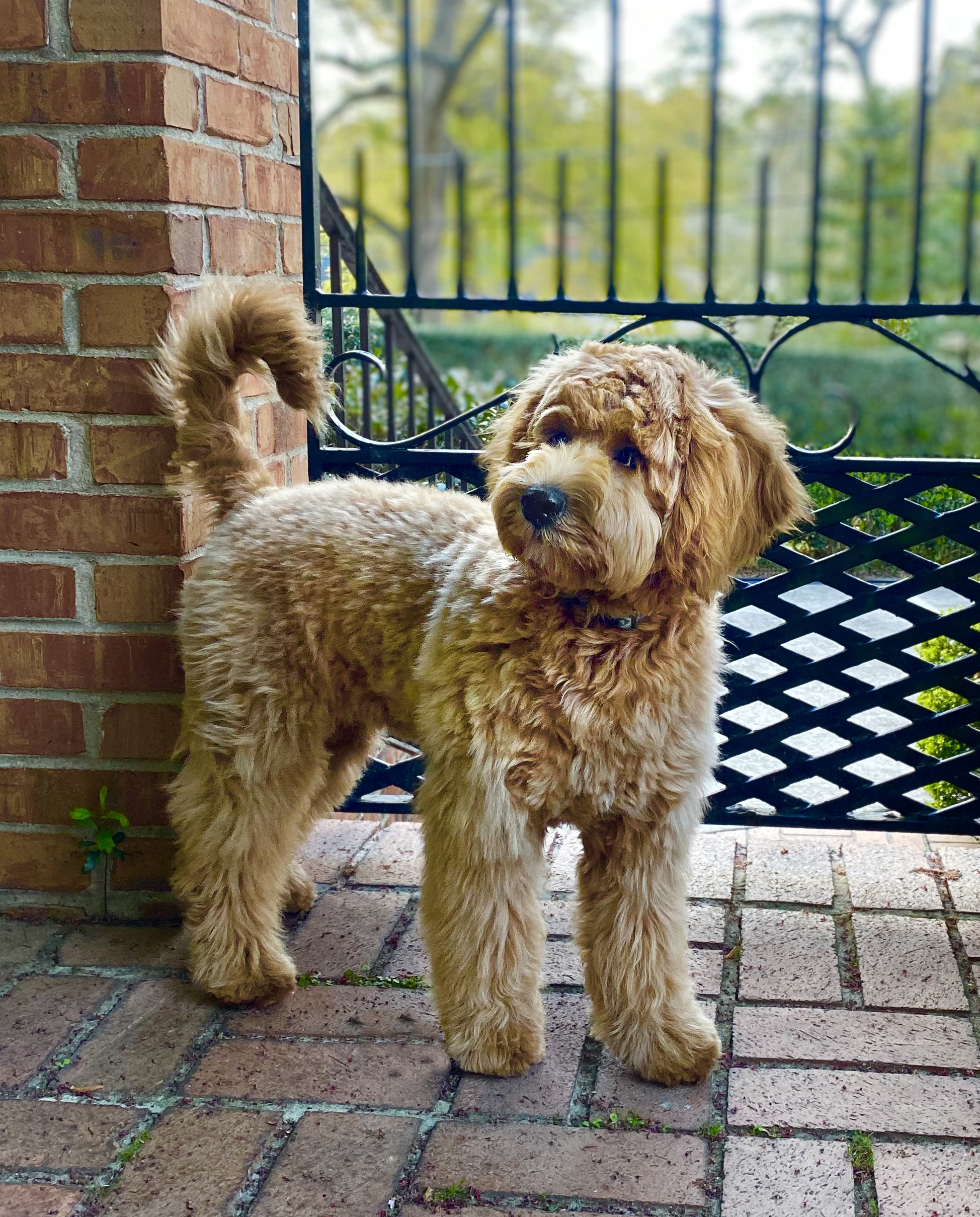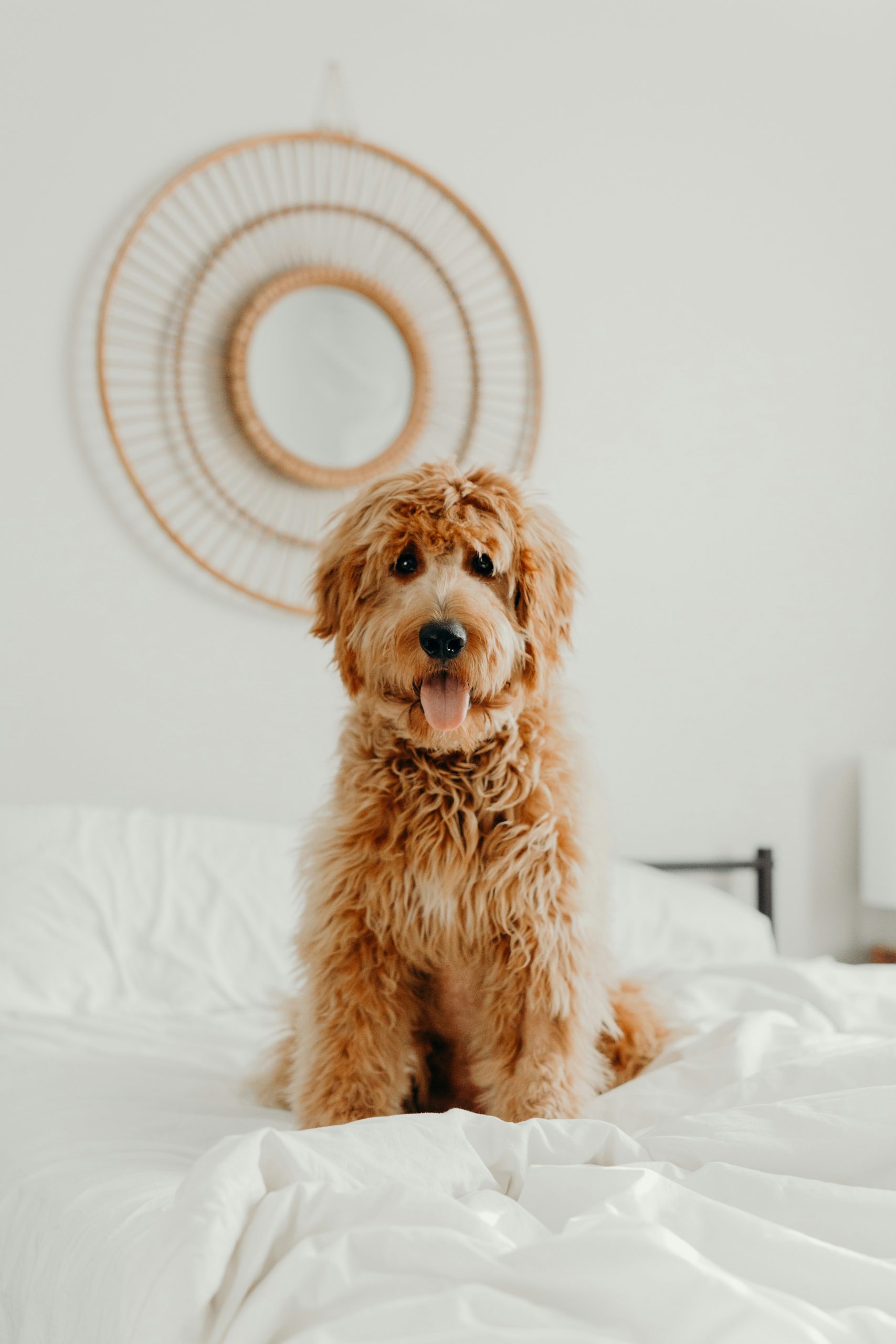
Photography courtesy of Seventh Heaven Goldendoodles
Schnoodle, woodle, westiepoo, whew! Place a poodle in a candlelit room with another purebred canine, play a little Marvin Gaye, and whoopsie-doodle, you have puppies! There are currently more than 40 different types of these adorable tail-wagging crossbreeds. And the most popular of them all? The loveable, loyal, half golden retriever, half poodle goldendoodle — the original doodle dog.
The common assumption is that the Labradoodle, an Australian hybrid created by romancing a poodle with a Labrador, was the original doodle. But as they say down under, that’s just a “porkie pie.”
It is true that in the late 1980s Wally Conron, a native of Victoria, Australia, created a pooch for a highly allergic blind woman in need of a guide dog. Poodles are naturally hypoallergenic and Labradors are excellent service dogs, and so the first Labradoodle was born.
But the first doodle was actually a yankee doodle dandy, having been born and bred in Cape Cod, Massachusetts, more than a decade before that Australian Labradoodle opened its little puppy dog eyes. It was Monica Dickens, the great-granddaughter of Charles Dickens, who in 1969 first created hyopallergentic service dogs, and her canoodling canines of choice were a poodle and a golden retriever.
What was born from that union might best be described in her great-grandfather’s words as a dog with “a heart that never hardens, and a temper that never tires, and a touch that never hurts.”
They were the best of dogs, not the worst of dogs, and please sir, I want some more.

The mixing of a golden retriever and a poodle was truly inspired because not only do poodles rarely shed, they are also considered the second smartest dog in the canine community. The border collie consistently outsmarts the poodle but unfortunately has shedding habits appreciated only by the makers of Kleenex and Claritin. Golden retrievers shed less so and are also quite intelligent and easily trained. More importantly, they have an attentive, congenial temperament, making them the perfect choice for a service dog.
Pair the poodle with the golden retriever and you have a sweet, teachable, fun-loving puppy that would make even Scrooge as happy as a dog with two tails.
And if this were one of Monica Dickens’ great-grandfather’s novels, the world would have discovered the true value of generosity, gratitude, and goldendoodles back in 1969.
But it was more than 30 years later when Amy Lane, a horse breeder from Berkeley Springs, West Virginia, began breeding what is now considered the standard size goldendoodle and soon discovered a marketing roadblock. A standard goldendoodle may be the perfect dog, but ranging anywhere between 50 and 90 pounds means it is not the perfect size for many potential dog owners.
So, in 2002, Amy created the world’s first litter of mini goldendoodles, adorable petite puppies with the same intelligence, temperament, and hyopollergenic qualities as their standard sized brethren but only maturing to between 25 to 35 pounds. Demand for these compact crossbreeds skyrocketed and suddenly oodles of goldendoodles were everywhere.

No longer limited to a standard size, potential goldendoodle owners can now adopt their new furry family member in four different sizes, five different colors, and a variety of coat textures.
But as the gold rush for goldendoodles increased, so did the number of mean-
as-a-junkyard-dog backyard breeders who, driven by greed and ego, took advantage of those looking for a hypoallergenic forever friend and put the health and lives of countless innocent puppies in jeopardy. Lie down with these disgraceful dog distributors, and you will definitely get up with fleas.
In an effort to protect the puppies and encourage responsible procreation standards, Amy founded the Golden-doodle Association of North America, a nonprofit organization dedicated to the promotion of “healthy, thriving goldendoodles through ethical breeding, health standards, and education.”
Unfortunately, irresponsible puppy mill dealers have muddied the reputation of ethical dog breeders — those who make it their mission to see that these precious little golden fluff balls are responsibly bred, thoroughly health tested, and placed in loving, caring homes.
Adding to this confusion and controversy are those who believe that adopting a puppy from a shelter is the only ethical way of owning a pet. But attacking responsible breeders for the horrendous conditions in which some dogs are kept is really barking up the wrong tree. The blame for any inadequate canine care rests entirely with those monsters who abuse and neglect animals.
It is important to remember that no one is ethically bound to own a dog. Adopting a puppy from a caring and conscientious dog breeder for whatever reason — health concerns, a specific hobby requiring specialized canine skills, or the need for predictability in size and temperament before bringing a pet into the family home — doesn’t necessarily mean that a shelter dog has been denied its forever home. Without access to a reputable breeder, the people with specific dog needs would remain dog-less.
And that would be a dog-gone shame.
It is the goal of GANA to ensure that those who breed puppies do so under the strictest of guidelines — much stricter, in fact, than the American Kennel Club, which does not require members to do any sort of health testing. The GANA website features breeders who not only adhere to the GANA code of ethics but also perform specific health tests on their breeding dogs in order to ensure the continued health and well-being of goldendoodles. GANA categorizes breeders into different levels based on the number of health and genetic tests they conduct, with the Gold Level being the most prestigious GANA distinction.
One highly esteemed GANA Gold Level breeding establishment is found right here in Richland County. Cindy and Glenn Niske, owners and operators of Seventh Heaven Goldendoodles, originally showed Great Danes at AKC conformation events — a fancy word for dog shows — which led to a boarding kennel and the breeding of Great Danes. But their hearts were stolen by the darling goldendoodles that occasionally boarded with them.
“I started researching the goldendoodle breed in early 2017,” says Cindy, “and when I put them in my search engine, the first thing to pop up was GANA.” Cindy called the GANA office and found herself talking directly with Amy Lane, the person most responsible for making the goldendoodle America’s most popular hybrid. Bonding over their mutual love of all things golden, Cindy eventually bought her first two female goldendoodles directly from Amy, and Seventh Heaven Goldendoodles was off and running.
Because Cindy has vast experience in the AKC world and a passion for breeding, the GANA organization asked her to write the official breed “standard” — a blueprint for the characteristics, appearance, movement, and temperament for the ideal goldendoodle — in the hopes that their little hybrid underdog would one day become a recognized breed.
Because, no, in the dog-eat-dog world of purebred breeders, goldendoodles are not recognized as an official breed. “We’re not AKC approved because we are a hybrid breed,” says Cindy. “But technically by definition, we are. We have a breed standard and meet all the other requirements in the definition of a breed.”
Denying goldendoodle “breed status” based on its mixed heritage seems a tad duplicitous, given the lineage of all the top AKC breeds. Poodles were originally bred from the union of a now-extinct French water dog and the Hungarian water dog. Labrador retrievers were created in the 1830s by breeding small water dogs to Newfoundlands. The golden retriever was created in the late 19th century by crossbreeding flatcoated retrievers with tweed water spaniels and — gasp! — mixing a little Labrador, bloodhound, and red setter blood in there as well.
And the 2023 AKC pick for most popular breed: the French bulldog? Mid-19th century miniature bulldogs were bred with terriers and pugs to create what is now the new darling of the AKC community. It might take a while to teach those old dogs new tricks, but every dog has its day, and hopefully goldendoodles will one day be recognized as a breed of their own, despite their mixed heritage.
Caring for and breeding a number of goldendoodles can quickly overwhelm even the most spacious of homes. That’s why Seventh Heaven Goldendoodles has adopted the “guardianship” approach, where a dog lives with another family on the condition that it will be bred several times.
When the females are close to having puppies, they are brought back to the breeder, who cares for both the mother and puppies all through the whelping, weaning, and socialization process.
“I don’t go anywhere during that time,” says Cindy. “They are born in my house, right beside my master bed. I am a thousand percent focused on those puppies.”
Once that litter of goldendoodle cuteness has arrived, Gold Level breeders have a strict schedule they follow to prepare the puppies for their forever homes. “We start pee pad training when they’re two weeks old,” says Cindy. “And then we start introducing them to the outdoors. Their little brains just start opening up and blossoming.”
Crate training begins at around three weeks, and getting the puppies acclimated to everyday sounds and distractions is also a priority. A reputable breeder will work on daily stimulation, noise desensitization, socialization, enrichment, and early command training, and provide plenty of outdoor playtime.
Obviously, Seventh Heaven is an example of all that is good in goldendoodle breeding. But how can a potential puppy owner make sure they are dealing with a reputable breeder?
“I think there’s a lot of responsibility on the puppy buyers to find a good, responsible, respectable breeder,” says Cindy. “But people just don’t know how to do that.”
The following are some guidelines for finding the best of breeders:
Make sure the breeder performs all the GANA recommended health tests.
Find out about the puppy parents. Reputable breeders should be able to provide detailed genetic reports and knowledge of the puppy’s lineage.
Take a tour of the facility to ensure that all dogs are kept in comfortable living conditions.
Good breeders belong to accredited organizations, such as GANA, GoodDog, or TellTail.
Make sure the breeder isn’t selling to pet stores or puppy brokers. That screams “puppy mill.”
A responsible breeder should only be focused on one or two breeds of dog.
A written application and a deposit should be required when purchasing a puppy, and conversations should include how you will be caring for the puppy once it is placed in your hands. If the breeder doesn’t care where the puppy is going, they are not in the business for the right reasons.
If the breeder says you can take the puppy home before it is eight weeks old, don’t take the puppy home at all.
Breeders should be happy to explain how they promote proper puppy socialization.
Good breeders should be a source of education and support throughout the entire life of your goldendoodle and will take the dog back if you are no longer able to care for it. The goal is happy and healthy puppies and dogs. That doesn’t stop once they leave their birthplace.
So, if your heart is set on these wonderful little creatures, find a breeder who is in it for the love of the goldendoodle and sees it as their mission to find each and every one of them the perfect home.
“God put me in charge of getting those puppies here safely, and raising those puppies correctly,” says Cindy, “but the biggest thing God put me in charge of was finding you — the puppy’s new owner. I trust you to love this dog unconditionally, for its entire life, and take the best care of it as long as you can.”
Because these little goldendoodle darlings? They are worth their weight in gold.










